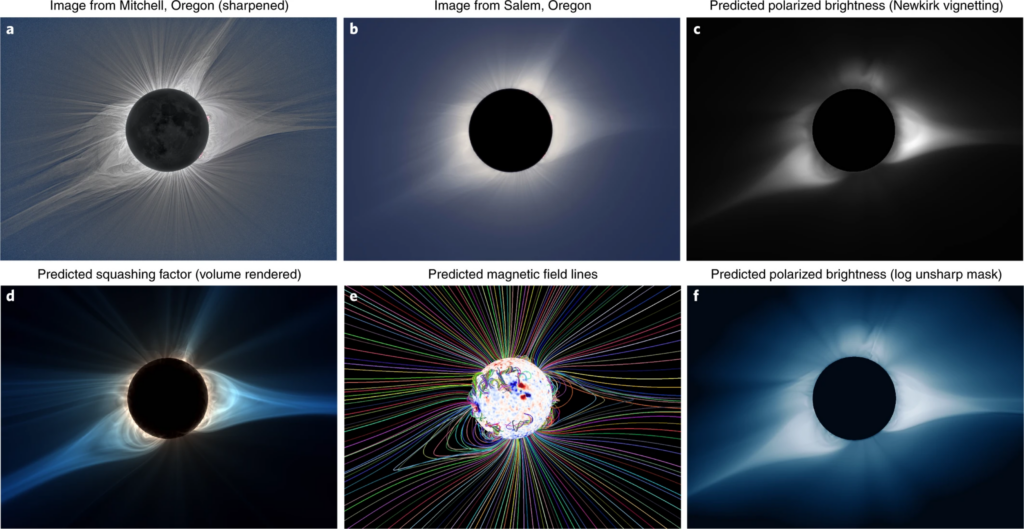On this page, we discuss several active areas of research in the global solar science community, including at the University of St Andrews, one of many hubs of solar research.
Why is the solar corona so much hotter than the surface of the Sun?
The Sun, as we know it, is a huge ball of hot plasma that hosts all life on our planet. Interestingly, it hides within itself many mysteries that have puzzled scientists for decades, waiting to be revealed. One such mystery is the coronal heating problem. Imagine moving away from a hot body such as a cup of coffee and measuring the temperature. One would intuitively expect a decreasing temperature profile from the surface of the cup. Unfortunately, the same argument cannot be applied to the Sun, as observations have shown a steep rise in temperature from about 6000 Kelvin on the photosphere to 1-3 million Kelvin in the corona which is just 2100 kilometres above (this is approximately 0.3% of the Sun’s radius!).
Meanwhile, in this region, particle density drops by about three orders of magnitude and according to the ideal gas law, since density and temperature are inversely related, a rise in temperature by the same amount is expected. However, detailed calculations have revealed that the falling of density alone is not sufficient to explain this steep temperature rise. There must be then, some hidden forms of energy that play a key role in the heating of the corona.
Scientists believe that this unusual temperature rise could be attributed to two mechanisms – nanoflares and magnetic waves. In the Solar and Magnetospheric Theory Group at the University of St Andrews, researchers simulate these phenomena to estimate the energy budgets required to sustain such high coronal temperatures. Other methods include the use of satellites such as the Parker Solar Probe and Solar Orbiter that make in-situ and remote observations of the corona to unravel its mysteries. The fact that the mechanisms mentioned above are of magnetic field origin and are difficult to observe makes the study of coronal heating even more challenging yet exciting.
Modelling the coronal magnetic field
Another major scientific question about the Sun, and an active topic of research within the Solar and Magnetospheric Theory group at the University of St Andrews, is the configuration of the Sun’s magnetic field. We can use computer simulations to generate a model of the magnetic field, and compare this with images of the magnetic field in the corona (obtained with satellites or during solar eclipses!) to try to improve our understanding of the physics of the Sun. Knowing more about the magnetic field in the corona lets us better understand space weather (the ‘weather’ of the Solar System), including major solar events like solar flares and coronal mass ejections (CMEs), or the solar wind.
CMEs are large-scale ejections of energy and matter from the Sun, and can cause significant disruption to satellites, electrical power grids and other systems on which modern society is reliant. Furthermore, their interaction with Earth’s magnetic field can drive large geomagnetic storms, which can produce spectacular aurorae and disruption of magnetic navigation (the compass!).
At the University of St Andrews, global (i.e. the entire Sun) models are used to enhance our understanding of the solar corona and space weather. These computational models are utilised to investigate possible new physics on the Sun, the benefits of the placement of new satellites for future observations, and the formation and eruption of solar flares and CMEs that can contribute to large-scale space weather events. Additionally, these models can be improved by studying how the structure of the corona in simulations compares with observed coronal fields.
Solar eclipses are a valuable component of this research; an eclipse provides an unrivalled opportunity to observe the structure of the magnetic field in the low corona. Many scientific studies on the corona, including Mikic et al (2018) (see figure below), simulate from observations taken some time before the eclipse (e.g. 10 days) through to the day of totality, and compare the simulated field structure with images taken on the date of the solar eclipse. The work of Mikic et al. (2018), which included contributions from Prof. Duncan Mackay at St Andrews, is one example of how we can use computer simulations to better understand the Sun and the Solar System.

The rare clarity in observations of the structure of the coronal magnetic field during a solar eclipse allows us to test computational models to see how they can be improved. This, in turn, allows us to better understand the physical processes that occur those 150 million kilometres away. Although science has progressed far since the first photograph of the moon perfectly occluding the sun, solar eclipses have remained an important contributor to scientific research through to the present day.